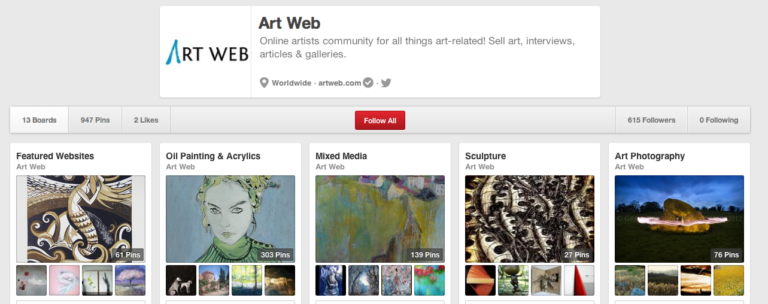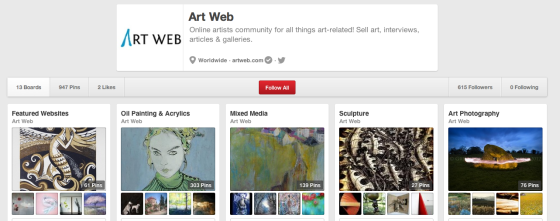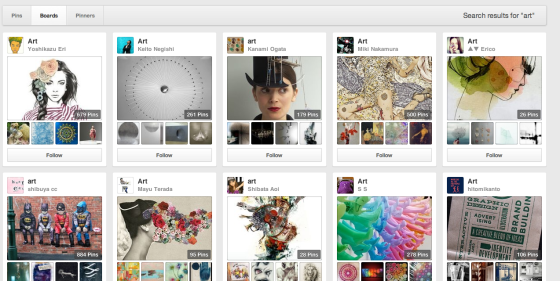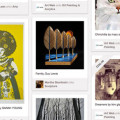Welcome to our 2-part series on Pinterest for artists! If you’re reading this, you’ll almost certainly have heard of it, but perhaps you’re still unsure about what exactly Pinterest does, or how to go about making it work for you. Or maybe you’ve even signed up, pinned some images, but are still not tapping in to the potential it can offer.
We’re here to give you some more reasons to be using Pinterest as you would Facebook and Twitter, as well as some helpful hints for how to get the most out of it. In this article, we’re going to be identifying what Pinterest is and how to sign up, as well as looking at how other people use it and who those people are. In the next article we’ll look at using Pinterest strategically, including some top tips on how to get the most from your content.
ArtWeb on Pinterest
1. What is Pinterest?
Put simply, Pinterest is a visual bookmarking tool. It enables you to collate inspiring images you find on the web, ‘pins’, and categorize them on your profile onto ‘Boards’. The most important factor, though, is that unlike a personal bookmarking system you might already have in your browser, Pinterest is public. It’s also a social networking community. This means that as you start to build up a network of followers, as you might on Facebook or Twitter, your pins will be seen by more and more people. This is a very exciting marketing tool for artists, as it means your images have the potential to be seen by hundreds, or thousands of people. You could even go viral!
Pinterest has over 70 million world-wide users, and is continually growing. With such massive potential to tap into your target audience, it would be crazy not to get involved!
2. Why is it any different to other social networks?
There are a number of reasons why Pinterest is a bit different to other social networking services. Of course, all platforms work best when used in conjunction with an overall marketing plan, but here are some of the ways Pinterest can offer value where others may not:
- It’s instantly visual. Pinterest appeals to visual people, because it talks in images. You can of course add text and titles to the images you pin, but people will primarily respond to the visual content. For artists, this is a clear winner.
- Content has a longer lifespan. Unlike Twitter or Facebook, where comments or Tweets are relevant for a certain time but become buried in the page history after a certain timeframe, Pins are continually visible. According to statistics, 50% of traffic from a pin comes after 2.5 months of the original pin date!
- Each pin leads back to it’s original source, even when re-pinned or shared by others.
- The Pinterest audience is actively looking for inspiration, and this a great place to jump in an show them what they were always looking for…
2. Who uses Pinterest and why?
Although so many people use Pinterest, it’s actually still quite niche in terms of it’s audience members. For example, according to statistics, 80% of Pinterest users are female, and over 50% are between 25 and 45 years old. It is also targeted towards specific interests, with crafts, DIY, arts, health and fitness, beauty, and weddings being popular subjects. With this in mind, you can start to see how the Pinterest audience identifies with creative ideas, and more importantly, how this is particularly relevant for artists.
A quick search for ‘Art’ on Pinterest boards…
3. Getting started
Signing up
If you are planning to use Pinterest to market yourself as an artist, the best thing to do is to use the ‘sign up as a business‘ option.
As well as the basic information you’ll need to enter, here are a few tips on setting up your profile in the best possible way:
- Use your own name. It sounds obvious, but make sure you put your actual practicing artist name, rather than using a nickname. It’s common sense, but a surprising amount of people don’t do it! It’s a little trickier when choosing a username because of the character limit, but again it’s best to keep as close to your business name as possible.
- Write a great ‘About’ section. Give a clear, concise and informative paragraph about who you are, and what you’re all about. You want to capture people in the first sentence, so make it a good one!
- Verify your website link. Doing so will show on your profile as a genuine website link, and will also enable you to access valuable analytics. It’s a really simple process, and the link to do so will be visible on your profile page when logged in.
- Put the ‘Pin-it’ button on your own website. This is one of the first things you should do, as it enables your website visitors to easily pin content from your site onto their own boards.
Setting up your boards
When you’re first starting out, it’s advisable to set up a few boards to start to fill out your profile straight away. This is going to take some dedicated time, as you want to make sure you’re posting relevant images that you’re target audience will want to see. Make sure the boards you create are inspiring, and tap into the creative mindset of your ideal followers. Also, the more pins you have, the better – don’t start a board and leave it with just a couple of images, as this will make your profile seem a little thin on the ground. Here are some things to consider…
- Your audience. The bulk of your content should be aimed at what your audience enjoys, and what they want to see.
- Titles. Make them interesting – you want to capture people’s imagination, so try and take a unique angle on your subject matter
- Descriptions. Use keywords in your board descriptions to improve your search visibility.
- Your work. Although Pinterest is great for promoting your work, this should really make up a small part of your overall activity.
- Personality. When you’re selling artwork, you want people to see the real you. That’s how sales are ultimately made – by connecting beyond the art itself. So make sure your boards really represent you as an artist, as well as thinking about what your specific audience want to see.
Some examples of successful Pinterest accounts
Dezignzilla – Mainly pinning interior design and style advice, the lady behind these boards has got it just right, and has the following to prove it! We really like her use of board titles and honing in on specific subjects.
Ginny Branch – This prop stylist’s profile has a beautifully coherent sense and tone, which has attracted over 100,000 followers.
Bonnie Tsang – Photographer Bonnie has used Pinterest as a way to share her personality and personal style, which in turn reflects on her own photography business.
We hope this article has helped you start thinking about the potential Pinterest has to offer artists, and inspired you to give it ago. It’s an extremely valuable marketing tool when used well, and best of all, it’s fun! We’ll be back soon with Part 2, where we’ll be looking more in depth at strategies to get more visibility, and more direct traffic to your site.








